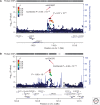Complex genetics and the etiology of human congenital heart disease
- PMID: 24985128
- PMCID: PMC4066638
- DOI: 10.1101/cshperspect.a013953
Complex genetics and the etiology of human congenital heart disease
Abstract
Congenital heart disease (CHD) is the most common birth defect. Despite considerable advances in care, CHD remains a major contributor to newborn mortality and is associated with substantial morbidities and premature death. Genetic abnormalities appear to be the primary cause of CHD, but identifying precise defects has proven challenging, principally because CHD is a complex genetic trait. Mainly because of recent advances in genomic technology such as next-generation DNA sequencing, scientists have begun to identify the genetic variants underlying CHD. In this article, the roles of modifier genes, de novo mutations, copy number variants, common variants, and noncoding mutations in the pathogenesis of CHD are reviewed.
Copyright © 2014 Cold Spring Harbor Laboratory Press; all rights reserved.
Figures





References
-
- Cordell HJ, Bentham J, Topf A, Zelenika D, Heath S, Mamasoula C, Cosgrove C, Blue G, Granados-Riveron J, Setchfield K, et al. 2013a. Genome-wide association study of multiple congenital heart disease phenotypes identifies a susceptibility locus for atrial septal defect at chromosome 4p16. Nat Genet 45: 822–824 - PMC - PubMed
-
- Cripe L, Andelfinger G, Martin LJ, Shooner K, Benson DW 2004. Bicuspid aortic valve is heritable. J Am Coll Cardiol 44: 138–143 - PubMed
Publication types
MeSH terms
Grants and funding
LinkOut - more resources
Full Text Sources
Other Literature Sources
Medical
